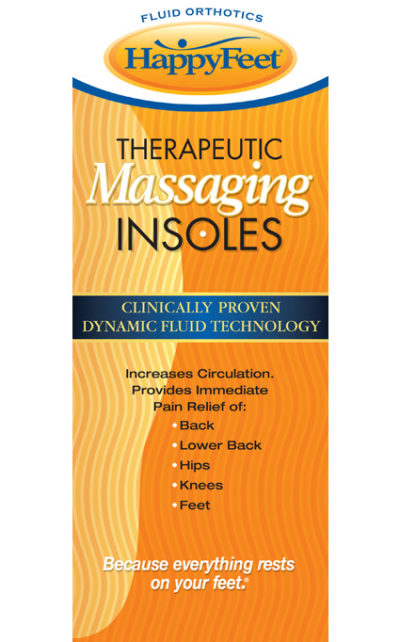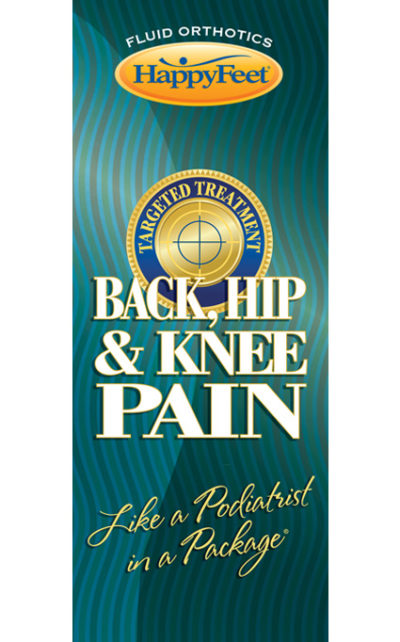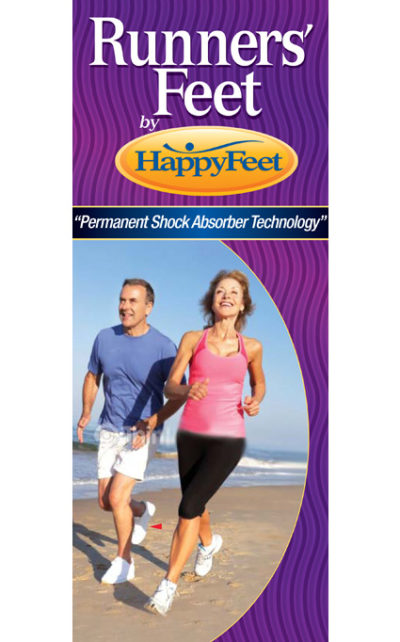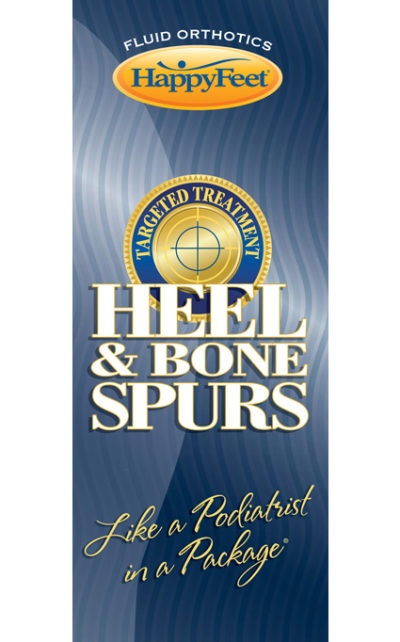Clinical Study 1
The Efficacy of HappyFeet Insoles on the Circulatory System and Lower Extremity Health
A Randomized Controlled Efficacy Study
Gary Merrell, M.D.
Lara Miller, RVT
Marissa Campbell
![]() Venous Stasis is a common disorder and places the general population at risk for deep vein thrombosis, lower extremity edema, cellulitis, thrombophlebitis and many other complications of compromised circulation. Because of the vast number of people affected by this disorder and the potential benefits of HappyFeet® insoles on the circulatory system, the primary investigators, including Sona Imaging Solutions, Inc., and 1910 Consulting, were interested in determining the efficacy of HappyFeet® insole use on the circulatory system and lower extremity health. While there have been efficacy studies on the effects on shoe insoles in regards to pain perception, there is no previous data on an insole that can increase circulation, reduce pain and overall fatigue.1-5
Venous Stasis is a common disorder and places the general population at risk for deep vein thrombosis, lower extremity edema, cellulitis, thrombophlebitis and many other complications of compromised circulation. Because of the vast number of people affected by this disorder and the potential benefits of HappyFeet® insoles on the circulatory system, the primary investigators, including Sona Imaging Solutions, Inc., and 1910 Consulting, were interested in determining the efficacy of HappyFeet® insole use on the circulatory system and lower extremity health. While there have been efficacy studies on the effects on shoe insoles in regards to pain perception, there is no previous data on an insole that can increase circulation, reduce pain and overall fatigue.1-5
Objective: To determine the efficacy of HappyFeet® insoles in increasing
circulation in the lower extremities while decreasing daily pain and fatigue.
Design, Setting and Participants: A double-blind, placebo-controlled efficacy
study was conducted from November 30, 2010, to January 7, 2011 consisting of
a volunteer sample of 30 adults ranging in age from 20-70 years old, all suffering
from at least one form of lower extremity or back pain. All testing was performed
at the Sona Imaging Solutions, Inc., facility in Orange City, Florida.
Interventions: HappyFeet® insoles were worn for a minimum of 6 hours daily
for a period of 30 days by each of the participants.
Main Outcome Measures: Participants rated pain in the foot, knee, leg, back as
well as headaches using the metered visual analog scale [VAS] at 0 and 4 weeks.
Daily recovery time from pain and fatigue was measured in minutes and reported
at 0 and 4 weeks. Venous Doppler ultrasound and echocardiography studies were
performed at 0 and 4 weeks, with imaging taken both with and without the
insoles. A TekScan® pressure mapping in-shoe device was used with and without
the insole, while standing, rocking and walking.
Results: Venous Duplex Ultrasound findings prove that HappyFeet® insoles
provide a valuable method for increasing venous circulation, when compared to
no insole use. There was a significant decrease noted in lower extremity pain,
after insole use. Some participants were documented to have increased
circulation in the lower extremities as much as 115%. On 65% (70) of the lower
extremities tested there was an average increase in venous circulation of 53%.
There was elimination in foot pain in 7 of the participants. A 78% reduction in
foot pain was experienced in 16 of the participants. Leg pain in 9 of the
participants was reduced by 69%. Knee pain was eliminated in 4 participants
while 11 participants experienced a 71% reduction. There was a 72%
improvement in back pain in 10 of the participants. Participants were able to
recover 49% faster from daily fatigue, allowing them to recover a total of 27
minutes faster than their average recovery prior to wearing HappyFeet® insoles.
As an overall group, 96% of participants noted that they enjoyed wearing Happy
Feet®.
Conclusion: HappyFeet® Insoles improve venous circulation because of the
position of the insole and the dynamic fluid stimulation of the venous
plexus during active use. In theory, this stimulation of the venous plexus at the
foot, in-turn forces increased volume of venous flow into the venules and veins,
thereby increasing the velocity and volume of venous return to the heart. Active
movement at the level of the foot has been determined to be a method for
improving venous stasis and the findings of this study are significant, in revealing
this to be true. HappyFeet® insoles are an effective way to increase lower
extremity circulation, decrease daily recovery time and decrease pain in the lower
extremities, thereby decreasing venous stasis and increasing the likelihood of
overall lower extremity health.
METHODS
1910 Consulting in conjunction with Sona Imaging Solutions, Inc., conducted a thirty day research study on the use of HappyFeet® dynamic insoles and the effects of the insoles on the cardiovascular system. Thirty volunteer participants were selected to take part in the research study. Participants were required to answer a pre-testing questionnaire regarding their lifestyle, overall general health, pain perception and any pre-existing conditions. The participants were evaluated by cardiac ultrasound to assess for ejection fraction, cardiac output, stroke volume and heart rate prior to insole use. Participants also underwent non-invasive venous duplex ultrasound testing, in order to evaluate the velocity and spontaneity of venous flow within the popliteal veins bilaterally, immediately prior to and just after initial insole use. The participants were then evaluated using the TekScan® F-Scan® in shoe pressure monitoring system in order to assess for immediate changes in pressure with and without insole use. Participants returned for re- evaluation by ultrasound after regular, daily use of the insoles for thirty days. Of the 30 initial participants 24 returned for follow- up testing. Six did not return, four of whom were given a static, foam insert placebo.
Placebo
The findings of the single returning participant who received the placebo insole were critical in documenting the increase in venous circulatory return with the use of the HappyFeet® insoles, versus the use of a non-dynamic, static insole. The average increase of velocities documented for this participant was 55%, as compared to the venous flow velocities with the non-dynamic, static insole in place.
PARTICIPANT OVERVIEW
In order to better understand the effectiveness of HappyFeet® insoles, the researchers needed to understand the history of its volunteer participants. Prior to the study and before the insoles distributed, participants were given a questionnaire, which included questions regarding age, general overall health history, lower extremity health, survey of insole use to date, types of footwear worn regularly by participants, basic lifestyle information, daily pain perception, methods used for recovery and the time it takes for participants to return to a “normal” state without pain after a work day. The study included 17 female participants and 11 male participants. Of these volunteers, five ranged in age from 20-30, nine from 31-40, three from 41-50, seven from 51-60, and finally six participants ranged from age 61- 70.
GENERAL HEALTH
Responses by study participants to the general health questionnaire were as follows: Two participants considered themselves to be in excellent health, 13 in very good health, 14 in good health, and one participant admitted to being in fair health. Contributing factors to these current states of health included heart disease, diabetes, arthritis, scoliosis, high cholesterol, high blood pressure, hypothyroidism, osteo porosis, fibromyalgia, and osteopena. Other contributing factors specifically targeting participants’ lower extremities included flat feet, heel spurs, plantar fasciitis, old injuries, calluses, poor circulation, arthritis of the feet, arthritis of the back, and Morton’s Neuroma. Of the participants studied, 24 said they did not smoke, six did smoke between a quarter to a pack and a half of cigarettes per day. The activity level of the participants was also an important factor when studying the participants’ lifestyle. The amount of time each of them spent standing, walking, and sitting in a 24-hour period gave the research team an idea of how many hours a day would be spent actively wearing the insoles. During the 30 day trial, participants noted that they spent an average of 4.5 hours standing, 3.5 hours walking, and 6 hours sitting per day.
PAIN PERCEPTION RESULTS
GENERAL PAIN AND RECOVERY
When asked, half of the participants felt that they had experienced less daily pain; a 43% decrease was noted in general pain by the end of the study. Participants said they had 49% less fatigue and were able to recover 27 minutes faster than before wearing HappyFeet® Insoles. Both the participants and the researchers believed that this was a significant finding.
FOOT
Though only 20 of the 24 returning participants admitted to having foot pain going into the study, 16 out of those 20 participants noticed a significant reduction of pain after wearing HappyFeet®. The average reduction in foot pain in 16 of the participants was 78%, while seven of the participants noted elimination of foot pain. Of all participants in the study, 54% said they thought they experienced less foot pain while wearing HappyFeet®.
HEEL
Of the 24 returning participants surveyed, 11 reported having no history of heel pain, while nine participants declared a reduction in heel pain after wearing HappyFeet®. Only four participants were unable to notice a decrease in heel pain.
LEG
When assessing leg pain, nine of the 24 returning participants observed an average decrease in pain of 69%.
KNEE
A total reduction in knee pain was experienced by four out of 24 involved in the study, while 11 participants experienced a 71% reduction in overall knee pain.
BACK
When asked about back pain, 62% confirmed that HappyFeet® insoles successfully reduced daily back pain. In fact, 10 of the 24 participants saw an average improvement of 72%. Of the participants, 20% did not experience any previous back pain therefore no change was noted.
HEADACHES
Out of the 24 participants, nine had a history of moderate to severe headaches. Of these nine, five reported their headaches were eliminated and six reported the headaches were significantly less severe after wearing HappyFeet®.
Other
Other notable data: 68% of the participants noticed warmer feet after wearing HappyFeet® insoles; of those surveyed, 34% noticed a decrease in daily lower extremity swelling and a 28% decrease in numbness; 64% of the participants confirmed that HappyFeet® insoles were indeed effective. 96% said that they liked wearing HappyFeet® and 52% reported they had more energy at the end of the day.
ULTRASOUND FINDINGS
A total of 65% of the participants extremities that were evaluated during the initial pre-trial studies revealed an immediate increase in venous peak systolic flow velocities when the HappyFeet® dynamic insole was used, versus evaluation with no insole in place. This finding proved that HappyFeet® insoles provide a valuable method for increasing venous circulation, when compared to no insole use. Of the participants who experienced an increase in venous flow velocity, the average increase was 53%, as compared to the venous flow velocities without the insole in place. After use of the HappyFeet® insoles for 30 days, 46% of participants revealed an increase in ejection fraction and overall left ventricular systolic function. Of those participants who experienced an increased ejection fraction, the average increase was approximately 8%, proving that HappyFeet® insoles are beneficial to the cardiovascular system by improving overall cardiac function. The findings of the participant which received the placebo insole documented the increase in venous return with the use of the HappyFeet® insoles, versus the use of a non-dynamic, static insole. The average increase of velocities documented for this participant was 55%, as compared to the venous flow velocities with the non- dynamic, static insole in place.
TekScan® FINDINGS
All of the participants went through a 3-part series of TekScan® pressure mapping tests. Each sensor is equipped with 1,848 sensels to collect data. Standing, rocking and walking both with and without HappyFeet® provided data on how much force and contact pressure distribution were experienced with each step. All 30 of the participants saw a reduction in overall pressure on the bottom of their feet. There was also a significant increase in the amount of surface area on the participants foot that was used after HappyFeet® insoles were placed in the shoes.
Comment
Not all participants showed signs of compromised venous flow at the beginning of the study. When analyzing the pain perception data not all participants experienced pain in all areas. Data on those participants was inconclusive, therefore not included in the results. When asked to leave feedback 22 of the 24 final participant’s left positive feedback, one participant indicated the insoles made the shoe too tight while the remaining left no feedback at all.
Author Contributors: As principal investigators, Lara Miller, RDMS, RVT, RDCS, RCCS, Dr. Gary Merrell, M.D. and Marissa Campbell had full access to the data and take responsibility for the integrity of the study and its findings. Study Design and Concept: Campbell and Miller. Analysis of data: Merrell and Miller. Technical Writing: Merrell, Miller, Campbell and Cara Centko.
Funding/Support: This study was funded by HappyFeet USA, Inc. All insoles were provided by HappyFeet USA, Inc at no charge.
Role of the Sponsor: HappyFeet USA, Inc. was not involved in the design of the efficacy study, data collection/analysis, interpretation or paper composition.
References
1. Phyllis M. King: A comparison of the effects of floor mats and shoe in-soles on standing fatigue. Applied Ergonomics Volume 33, Issue 5, September 2002, Pages 477-484.
2. Ellen Sobel, DPM, PhD, Steven J. Levitz, DPM, Mark A. Caselli, DPM, Paul J. Christos, MPH, MS and Jonathan Rosenblum, DPM: The Effect of Customized Insoles on the Reduction of Postwork Discomfort. Journal of the American Podiatric Medical Association Volume 91 Number 10 515-520 2001.
3. Basford JR, Smith MA: Shoe insoles in the workplace. Orthopedics. 1988 Feb;11(2):285-8.
4. Tooms RE, Griffin JW, Green S, Cagle K.: Effect of viscoelastic insoles on pain. Orthopedics. 1987 Aug:10(8):1143-7.
5. Shabat S, Gefen T, Nyska M, Folman Y, Gepstein R.: The effect of insoles on the incidence and severity of low back pain among workers whose job involves long-distance walking. Eur Spine J. 2005 Aug;14(6):546-50. Epub 2005 Jan 25.
6. Ahroni JH, Boyko EJ, Forsberg R.: Reliability of F-scan in-shoe measurements of plantar pressure. Foot Ankle Int. 1998 Oct;19 (10):668-73.






